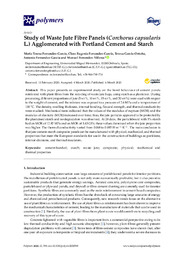Título :
Study of Waste Jute Fibre Panels (Corchorus capsularis L.) Agglomerated with Portland Cement and Starch |
Autor :
Ferrández-Villena, Manuel
Garcia-Ortuño, Teresa
FERRÁNDEZ, MARÍA TERESA
Ferrandez-Garcia, Clara Eugenia
Ferrández García, Antonio |
Editor :
MDPI |
Departamento:
Departamentos de la UMH::Ingeniería |
Fecha de publicación:
2020 |
URI :
https://hdl.handle.net/11000/34601 |
Resumen :
This paper presents an experimental study on the bond behaviour of cement panels
reinforced with plant fibres from the recycling of waste jute bags, using starch as a plasticiser. During
processing, di erent proportions of jute (5 wt %, 10 wt %, 15 wt %, and 20 wt %) were used with respect
to the weight of cement, and the mixture was exposed to a pressure of 2.6 MPa and a temperature of
100 C. The density, swelling thickness, internal bonding, flexural strength, and thermal conductivity
were studied. Mechanical tests indicated that the values of the modulus of rupture (MOR) and the
modulus of elasticity (MOE) increased over time; thus, the jute particles appeared to be protected by
the plasticised starch and no degradation was observed. At 28 days, the particleboard with 5% starch
had an MOR of 12.82 MPa and an MOE of 3.43 GPa; these values decreased when the jute proportion
was higher. The thermal conductivity varied from 0.068 to 0.085 W m1 K1. The main conclusion is
that jute-cement-starch composite panels can be manufactured with physical, mechanical, and thermal
properties that meet the European standards for use in the construction of buildings as partitions,
interior divisions, and thermal insulators.
|
Palabras clave/Materias:
cement-bonded
starch
waste jute
composite
physical
mechanical and thermal properties |
Tipo de documento :
info:eu-repo/semantics/article |
Derechos de acceso:
info:eu-repo/semantics/openAccess
Attribution-NonCommercial-NoDerivatives 4.0 Internacional |
DOI :
https://doi.org/10.3390/polym12030599 |
Publicado en:
Polymers |
Aparece en las colecciones:
Artículos - Ingeniería
|
 La licencia se describe como: Atribución-NonComercial-NoDerivada 4.0 Internacional.
La licencia se describe como: Atribución-NonComercial-NoDerivada 4.0 Internacional.
.png)
